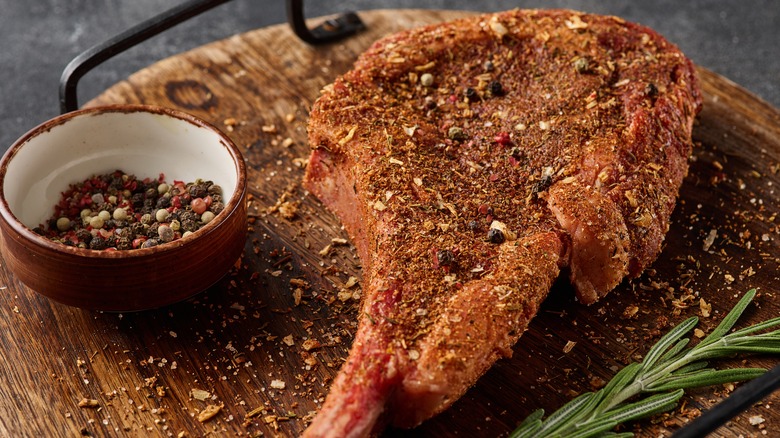Give Your Steak Caribbean Flavors With Kwame Onwuachi's 4-Spice Rub - Exclusive
"Top Chef" star Kwame Onwuachi is set to serve up a feast this year at the U.S. Open's Club-level restaurant, where he's prepping to cook hamachi escovitch, black bean hummus with berbere spiced lamb, crispy okra, and — for the tournament's beef lovers — a pepper steak made with ribeye. So what exactly should the tournament's foodies expect from the rising star of New York City's cutthroat culinary universe?
When the New York Times reviewed Tatiana, Onwuachi's recently opened NYC restaurant, it raved about Onwuachi's "both extravagant and homey" dishes with "dynamic and thrilling" flavors from the "Afro-Caribbean canon." While not on Tatiana's menu currently, the ribeye that the Onwuachi will serve at the Open undoubtedly fits the description. And if you're hungry for new steak prep tips, pay heed. In an exclusive interview with Tasting Table, Onwuachi told us that much of his ribeye's flavor profile comes from a four-spice Caribbean-inspired rub. "I'm seasoning it with a sazón. It's pretty much found in Puerto Rico and the Dominican Republic. The spice blend [is] heavy on the paprika, garlic, [and] onion. I [also] put a touch of cumin in it," he revealed.
The key to getting a rub right, according to Kwame Onwuachi
While the spice rub alone sounds delicious, Kwame Onwuachi takes the flavor up a notch by combining his Caribbean sazón with an aromatic-heavy marinade. After applying the sazón to his meat, the chef told us that he lets the ribeye sit in "a slew" of aromatics — a mix of onions, garlic, culantro, and sofrito — which work with the rub to heighten the beef's Caribbean flavors and increases its tenderness.
Because the "Top Chef" star applies both a rub and a marinade to his meat, timing is paramount to success. Per the celeb chef, if you try this technique yourself, you'll want to be cautious not to overdo it — particularly with the spice blend. "Let [the rub] sit for at least an hour up to 24 hours, maybe, no longer than that," he recommended. "You don't want it to denature the protein, especially [because] there's all those aromatics in there that start to break it down [afterward]."

